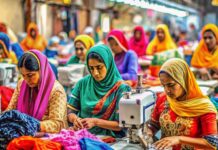New Delhi: The domestic textile industry requires urgent reforms in areas such as supply chain integration, cost efficiency, and adherence to sustainability standards to maintain its competitive edge, according to a report released by the government think tank Niti Aayog on Friday.
In its report titled “Trade Watch July-September (Q2) FY25,” which assesses the competitiveness of the textile sector, Niti Aayog underscored the industry’s vital contribution to the country’s industrial output, employment, and exports.
The sector represented 5% of total exports, valued at $34.2 billion in 2023.
Despite being one of the oldest industries in India, its share in the global market remains limited at 4%, placing India as the sixth-largest exporter of textiles and apparel.
“India holds strong competitiveness in natural fibre-based textiles, particularly cotton and carpets, but faces challenges in apparel exports and other technical textiles, where Bangladesh and Vietnam have outpaced it,” the report stated.
It pointed out that India has a moderate presence in man-made textiles but is falling behind in high-value technical textiles, a market largely controlled by China, Germany, and South Korea.
“Although India’s participation in global textile value chains has grown, the sector must undergo urgent reforms in supply chain integration, cost efficiency, and sustainability compliance to stay competitive in the global market,” the report continued. This need for reforms highlights the importance of textile sector reforms for competitive advantage.
According to data from the Ministry of Commerce and Industry, India’s textile exports amounted to $35.94 billion in FY24, reflecting a 1.95% decline compared to the previous year.
In contrast, garment exports from Bangladesh reached $44.47 billion in FY24, while Vietnam’s exports were also close to $44 billion.
For the past six years, India’s textile and apparel exports have consistently hovered around $40 billion, growing at a mere 0.8% annually, significantly lower than the global growth rate of 3.5%. This stagnation further emphasizes the need for textile sector reforms for competitive advantage.
“While the country exports 840 textile products, more than 52% of its exports come from just 134 items, in which India holds a global export share of over 10%. This indicates strong competitiveness in selected segments, but also the absence of diversification,” the report noted.
“China dominates global textile exports, leading in man-made textiles (50%), technical textiles, and traditional segments such as cotton and carpets. India’s dependence on China for synthetic fibre and technical textile raw materials presents a challenge for expanding exports,” it added.
Niti Aayog’s latest Trade Watch report also emphasized that increasing geopolitical fragmentation, especially between the US and China, is altering global trade dynamics as nations prioritize trade within their geopolitical spheres.
“While this shift disrupts traditional trade patterns, it creates new opportunities for emerging economies like India, particularly in sectors such as pharmaceuticals, IT services, and manufacturing,” it explained.
“However, heightened competition from Vietnam, Mexico, and Poland, coupled with stringent labour and environmental regulations, requires India to improve its ease of doing business, trade infrastructure, and regulatory alignment to leverage these changes effectively.” Addressing these challenges aligns with the necessity of textile sector reforms for competitive advantage.
Niti Aayog indicated that it will provide a comprehensive analysis of the Reciprocal Tariff Plan’s impact on India in the upcoming edition of Trade Watch.
“India’s trade landscape continues to evolve, driven by strategic policy reforms, resilient industrial growth, and expanding global partnerships,” stated B.V.R Subrahmanyam, chief executive officer at Niti Aayog.
“Despite its strong presence in natural fibre-based textiles, India’s share in the global textile trade remains modest, highlighting the need for innovation, modernization, and policy-driven competitiveness,” he concluded, reinforcing the call for textile sector reforms for competitive advantage.































